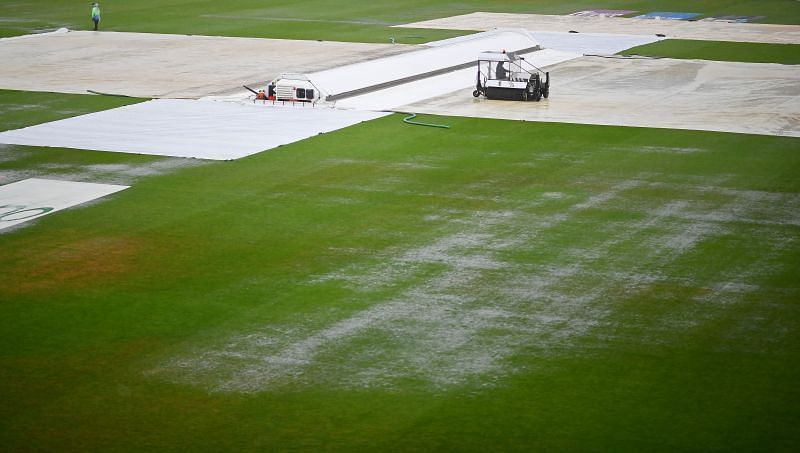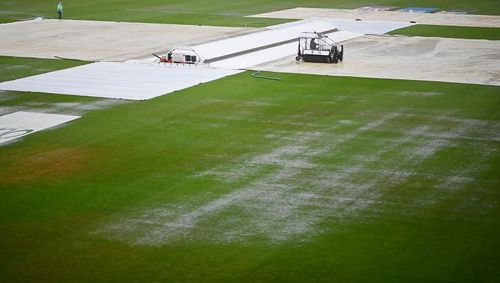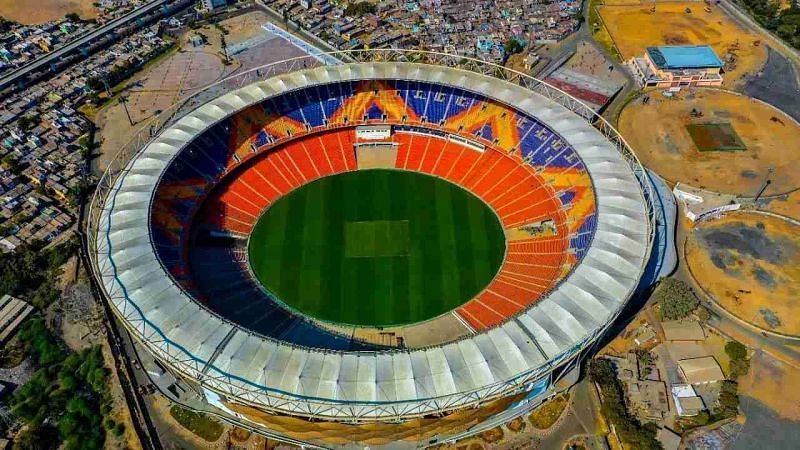
WTC final: From stadium roofs to 'Brumbrella,' can cricket solve its rain problem?

Let's face it, the World Test Championship (WTC) final isn't the first game disturbed by the rain gods, and it won't be the last.
As much as fans berate the ICC for keeping the all-important clash in the middle of the English monsoon in Southampton, it won't solve the vexing issue that has been plaguing the game for eternity.
There have been many on-paper attempts to nix the 'rain problem,' but practical results have been scarce.
The cycle of building excitement, waiting for months, and seeing even a drizzle romp over the hopes has continued unabated for years. Hiding it under the carpet as 'bad luck' doesn't work anymore either.
So, in this piece, we'll look at the solutions deployed in the past and how they failed as well as the solutions being looked at and how they can fail (or not).
We will also look at successful contingency measures that could be improved upon to make the great game a bit more waterproof.
Rain solution 1: Build a roof!
In a demand that sounds more like a political platitude than technical, fans often call upon their rich boards to 'build roofs' in the stadiums. But is it feasible?
Like walls, roofs extend to huge logistical issues to build. Putting up a couple of roofs at the Wimbledon cost almost £170 million, and tennis courts are way smaller and uncomplicated than cricket grounds.
Adding a roof to even one stadium in India will not only take years but will also shoot up gateway prices exponentially in the future.
Here's a functional example to look at. Australia's Docklands Stadium already boasts a marvelous retractable roof and has hosted a few international and Big Bash League matches in the past.
But even this peerless wonder makes its ends meet by hosting a panoply of other sporting events - the Australian Football League, the A-League, the National Rugby League, among others.
Moreover, the few cricket matches hosted here were facilitated with a drop-in pitch. This couldn't be a long-term rain solution for a World Cup or WTC final where tracks are prepared with extra care, sometimes going on for months.
Rain solution 2: Weather Balloon
A meeting between the England and Wales Cricket Board (ECB) and a Google subsidiary called X - The Moonshot Company in 2019 had raised speculations over a possible 'Weather Balloon' to protect the grounds from rain.
This was touted as a fine mesh over the entire ground suspended in the air by a large balloon, similar to those used for broadband networks in the UK. The details of the talks weren't released, and the fascinating idea has remained so.
However, even if it could be applied as a rain solution, the idea would have to go past a couple of logistical issues.
For one, extreme weather could heavily impact the mesh and even cause a mini-disaster with thousands of people spectating the game inside it. Authorities will also have to manage the water sliding off the mesh.
Nevertheless, the innovation will definitely be cheaper than a roof and, with some possible technological advancements, could be one to keep an eye on in the future.
Rain solution 3: Brumbrella
If you can't stop the rain, you should at least better manage it. Cricket matches, including the WTC final, are not only halted for the showers but also because the wet patches in the outfield sometimes take hours to dry out.
Countries like Sri Lanka and India have at least managed to mitigate this issue in the past decade.
Unlike England, where officials cover the pitch under a hovering cover and the rest of the inner circle under multiple sheets, some stadiums in the subcontinent cover the entire outfield in a massive tarpaulin whenever it starts to rain.
The system was also used in Edgbaston under the name 'Brumbella' from 1981 to 2001. However, it was banned after the ECB found flat covers caused 'sweating,' making the pitches damper and therefore much more difficult to bat on.
BCCI president Sourav Ganguly helmed the introduction of similar but more advanced covers at the Eden Gardens. The authorities here believe that these can assure the game's restart within 10 minutes without affecting the pitch or the ground.
The only issue with this method is that it requires a lot of manpower on the ground - something which isn't commonplace in countries like England and Australia, where labor costs are very high.
But the ICC should, at least for one-off, highly opulent games, consider making these logistical investments and preclude all avoidable delays.
Rain solution 4: Powerful drainage systems

In a solution on similar lines to the Brumbrella, stadiums around the world have started applying cutting-edge drainage systems to mitigate the effect of rain.
Using what is being called a 'sub-surface drainage system,' the newly-built Motera Stadium has the ability to dry out within 30 minutes of rain's stoppage.
Similar arrangements are already in place at the Chinnaswamy Stadium, Bangalore, Eden Gardens, Lord's, and the Melbourne Cricket Ground.
Such drainage systems will have to be more widely applied around the world combined with the aforementioned covers if cricket is to keep rain delays to a minimum.
It will certainly require massive investment, but that's exactly what's required, especially from countries that host the most multi-nation competitions.
Rain solution 5: More reserve days
Finally, if nothing works, cricket can bank on one of its closest friends to stave off rain-affected games - reserve days.
The waste of two full days in the WTC final opened a Pandora's box of questions, including: 'Can't we have another reserve day?', 'Can't we ignore the five-day game and play for 450 overs until a result is reached'?
These are certainly worth considering. In Sunil Gavaskar's era, Test matches used to be spread over six days and included a rest day between the third and fourth days.
Add to that a reserve day, and there can be a pitch to keep off a seven-day window for future WTC finals.
However, more than one reserve day is economically unfeasible in ODI, T20, and even bilateral Test matches. The logistical arrangements, broadcast rights, licenses, and intricacies of the ticketing system make a draw sound like a better option.
What we need right now is better management of rain delays which could be reached using some if not all of the above measures.
The ICC could also look at arranging viewer-friendly programs to keep the audience engaged and their revenues more stable even during these delays.
Challenges are vast, but it's high time that cricket took some decisive steps to get the oldest monkey off its back.